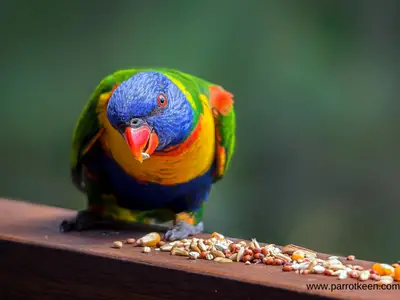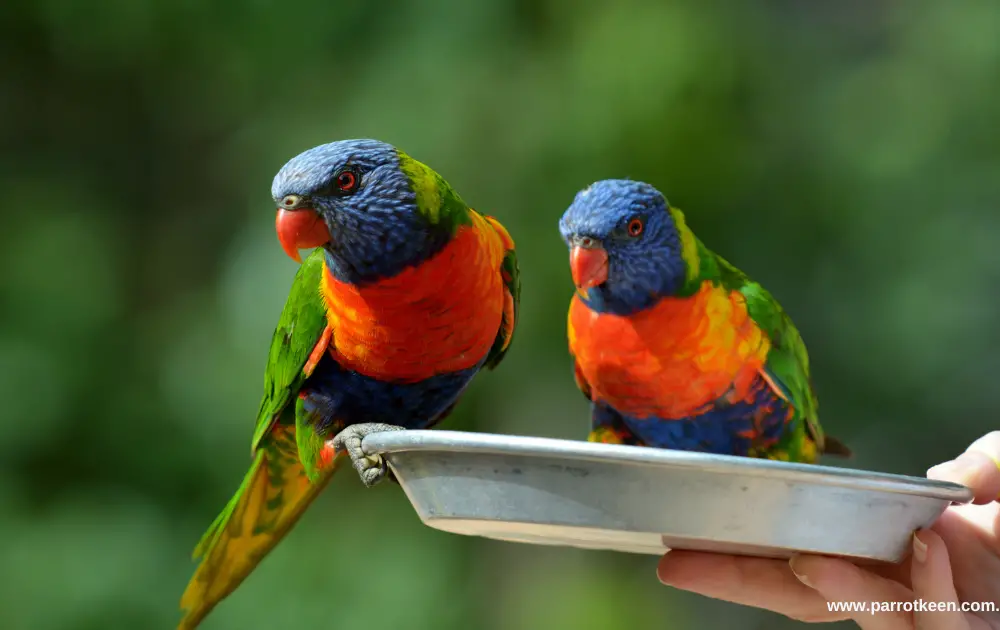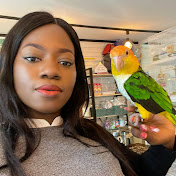![Homemade Lorikeet Food [EASY & SIMPLE!]](https://parrotkeen.com/wp-content/uploads/2022/08/Homemade-Lorikeet-Food.jpg)
Is homemade lorikeet food good for lorikeets and how do you prepare them? You will find out exactly how in this blog post.
Lorikeets are little, brightly colored parrots that can only be found in the western Pacific and the East Indies. They make excellent pets because of their ability to survive solely on nectar, pollen, and fruit.
To maintain their health, lorikeets should not be fed birdseed, according to research commercial lorikeet nectars and dry foods are available for those who can’t keep their lorikeets on their natural pollen and nectar diet in captivity.
Healthy and happy pet parrots can be fed homemade nectar and dry food mixtures with large portions of fresh fruits.
Rainbow Lorikeet Food List
Rainbow lorikeets just like every other bird out there enjoy eating foods that are tasty and will help them stay healthy.
Over, the years many bird owners have come to realize the importance of proper nutrition for birds. Poor nutrition in birds is one of the major causes of diseases in birds, hence it is important that as a bird owner, you take proper care to ensure that your rainbow lorikeets get the best nutrition for their health.
Taking adequate care of your rainbow lorikeet starts with understanding the rainbow lorikeet food list and knowing the things to feed your rainbow lorikeets and the things you must avoid.
Below is the rainbow lorikeet food list;
-
Fruits
Offer your rainbow lorikeets fruits such as oranges, apples, berries, pears, plums, peaches, grapes, etc, and watch them leap for joy enjoying them. It is important that you carefully observe to know the fruits they enjoy the most and include them in their diet.
There are fruits you must avoid giving to rainbow lorikeets as they are very poisonous and dangerous to them. An example of such fruit is avocado and foods that have been preserved with lots of additives like salt and sugar.
-
Premade Nectar
Premade nectars are good food options for lorikeets. Lorikeets enjoy eating nectar. In fact, they are naturally nectar feeders. In the wild, they feed majorly on native flowers like Grevilleas and bottlebrushes. However, domestic rainbow lorikeets can be fed either homemade nectars or premade nectars.
When you buy premade nectars to feed rainbow lorikeets you should the instructions to ensure that you prepare it correctly for lorikeets.
-
Pellets
Rainbow lorikeets can be successfully sustained on pelleted diets. Unlike, some birds rainbow lorikeets have firmer stools and this makes it easy for them to stay on a pelleted diet because you wouldn’t have to worry about the pellets disrupting their digestive system.
-
Vegetables
You can offer rainbow lorikeets sliced, shredded, or diced vegetables to supplement their diet. Rainbow lorikeets enjoy eating vegetables like tomatoes, celery, peas, cabbage, carrots, etc.
However, lorikeets may find it difficult to adjust to eating vegetables especially when you introduce them to them. It takes a little bit of effort and you will have to keep trying them with different vegetables until you identify the one they enjoy eating.
-
Water
Water is very essential for humans, plants, and animals. Rainbow lorikeets are not an exception they also need water daily for their health. You should give them fresh water daily and make sure to wash the water dish daily before replacing the water.
Doing this will ensure that there are no particles from the previous day left in the water. Drinking dirty water will do your rainbow lorikeet more harm than good.
Homemade Lorikeet Food

It is common knowledge that in the wild, young parrots learn what to eat by following their flocks. As a result of being reared in captivity, captive birds see humans as their flock.
You can be sure that everything you put in front of your birds will appeal to them for this reason. As a bird owner, it is your obligation to teach your birds how to eat healthfully. Pet birds are prone to a wide range of health issues, the majority of which stem from a lack of proper nutrition (vitamins and minerals).
To get nectar from flowering plants, lorikeets have a brush-like tongue that is specifically designed for this purpose. Also, in captivity, they must eat nectar-based diets. Feeding them seed permanently damages their “brush tongue,” which prevents them from eating their usual, liquid diet.
Obesity-related health issues and death can result from eating a seed-based diet, which is high in carbohydrates.
Food for Lorikeets should consist of a variety of fruits, blooms, and a nutritionally sound nectar blend. Some Lori Wet and dry products sold in pet stores are nothing more than sugar-sweetened rice flour and glucose, which is devoid of essential vitamins and minerals.
-
Make your lorikeet nectar at home.
There are commercial lorikeet nectars that you can easily feed your lorikeets but most times it is safer to make the nectar at home because you will be in control of the ingredients and quantities that go into the nectar.
Ingredients.
- 4 mugs of water
- 1 tablespoon pollen
- 1 tablespoon honey
- 2 mugs of high-protein baby cereal
- 1/2 teaspoon calcium carbonate;
- 1/2 teaspoon multivitamin powder
- Half a mug of dried skim milk in powder form.
Homemade lorikeet Food (nectar) can be made by following these procedures.
-
Step 1.
The ingredients listed above should be mixed to make a watery mixture:
-
Step 2
Freeze the mixture in ice cube trays.
-
Step 3
Make a daily ice cube feeder for each bird and use melted nectar to fill it.
Guide To Making Dried Lorikeet Food
-
Step 1
Make a lorikeet food mix out of dry ingredients. The following ingredients should be mixed: 1 cup glucose powder, 1 tea-spoon vitamin-mineral powder, and a dessert spoonful of pollen per 2 cups of rice baby cereal or flour.
-
Step 2
Refrigerate the dry food combination once it has been packaged in sealed jars.
-
Step 3
Keep a supply of the dry food blend on hand for your bird at all times.
-
Step 4
A daily diet of organic fresh fruits should be provided to your lorikeet. A variety of fruits, including apples, pears, mangos, oranges, melons, grapes, paw-paw, and tangerines, are said to be well-received by lorikeets.
What Do Lorikeets Eat In the Wild?

In the wild, the lorikeet’s diet is primarily made of nectar and pollen from flowers and blossoms. Recent, studies have shown that pollen is the major food for lorikeets in the wild. Lorikeets can also feed on insects and larvae they find in foliage and blossoms.
When domesticated, lorikeets require a lot of care and attention as well as a varied diet rich in fresh, nutritious items.
Fruits, vegetables, nutritional supplements, and even lorikeet-specific pellets are all viable possibilities for lorikeets to supplement their diet.
Do Lorikeets Eat Nectar?
Yes, lorikeets eat nectar. A lorikeet’s natural food source is nectar. Native flowers like bottlebrushes and Grevilleas provide nectar (pollen) for them in the wild. They do this with a brush-like tongue, which is peculiar to them. Berries and fruits, as well as greens, are all common food sources for them.
What Is The Finest Food For A Lorikeet?
As a rule of thumb, lorikeets should be supplemented with a diet created specifically for lorikeets. Ideal veggies are those that are orange, such as carrots, sweet potatoes, and pumpkin.
Do Lorikeets Require Nectar To Stay Alive?
In the wild, lorikeets and Lillies ingest nectar and pollens. Fruits, berries, blooms, and buds are also part of their diet. This species does not normally consume seeds in the wild. So, it is possible o say that in the wild, lorikeets require nectar to stay alive but when they are domesticated the nectar diet can be supplemented with fruits, vegetables, and pellets.
Is Honey Safe For Rainbow Lorikeets To Eat?
By feeding lorikeets sugar, honey, or jam-based meals, many people have attracted the birds to their gardens. Birds that feed on blossoms, such as lorikeets and honeyeaters, have a safe and nutritious food source in these plants.
What Can’t You Feed A Lorikeet?
Birds of Australia and New Zealand’s tropical regions, the lorikeets, are a common sight. Popular as pets, these birds require a wide variety of food to maintain a balanced diet because of their fast metabolism. You, like other birds, should steer clear of items like avocado and chocolate, which might harm your health. Contact your local avian veterinarian for a complete list of items to avoid.
Can Lorikeets Eat Weetbix?
Yes, Lorikeets can eat Weetbix. Weetbix being a whole-grain wheat breakfast cereal is an excellent option for lorikeet’s homemade food.
However, rather than being a normal part of their diet, WeetBix can be given to lorikeets as a treat rather than a regular food source.
Moderation is the key here, although it’s very safe. Birds like lorikeets require a balanced diet, just like any other species. Your avian veterinarian should be consulted for more information.
Conclusion: Homemade Lorikeet Food
Homemade lorikeets food such as nectar is very easy to make at home. The idea of making the food at home is to ensure that you are in control of the ingredient and the quantity that is just right for your lorikeets.
We hope that the simple guide above will help you make your first homemade lorikeet food. When in doubt about what to feed your lorikeet, call your local bird clinic.

Hi, I am Thersa and Welcome to ParrotKeen, your number one place to get all the information you need about your cute parrot. I hope You Find it useful.
